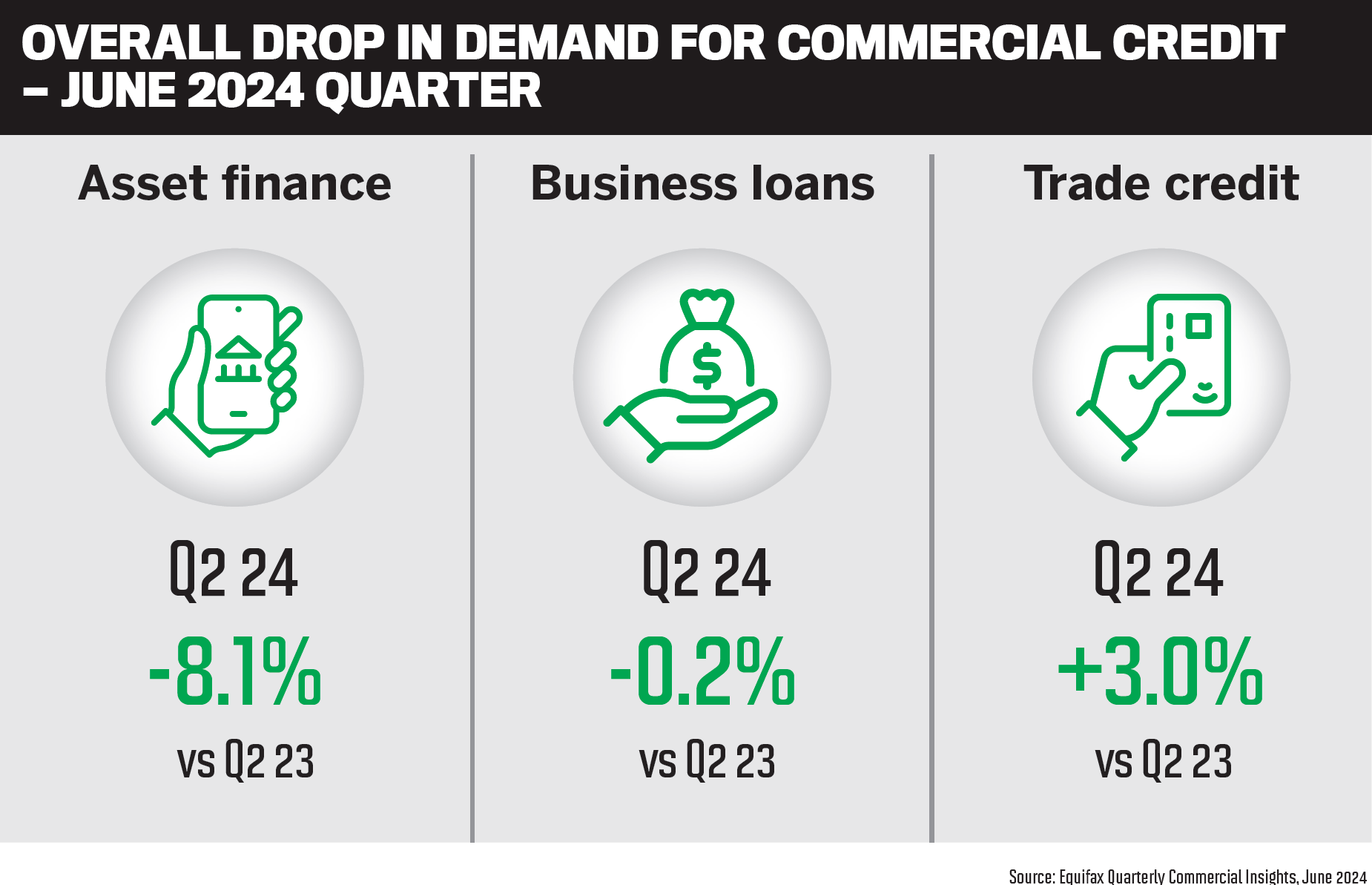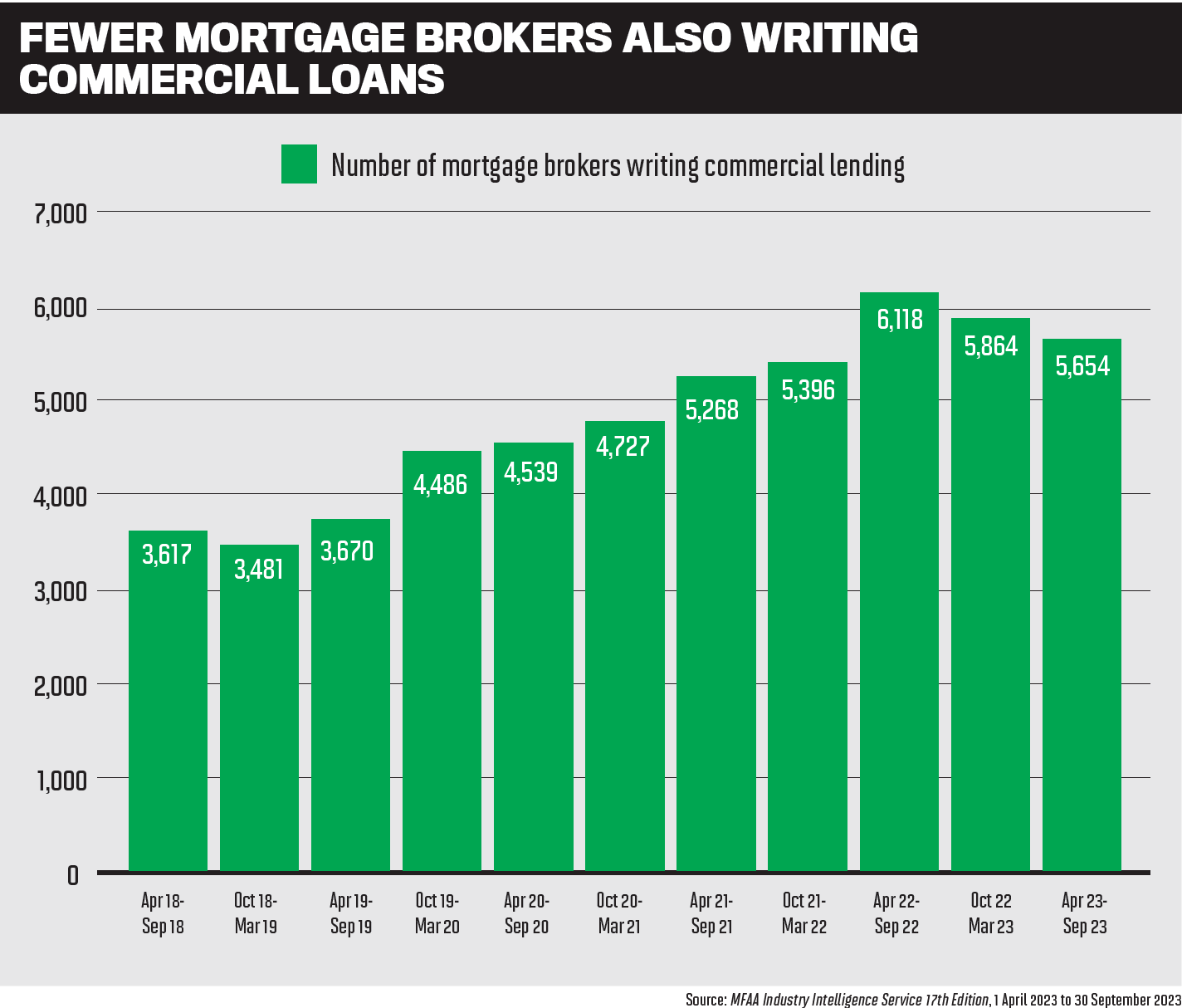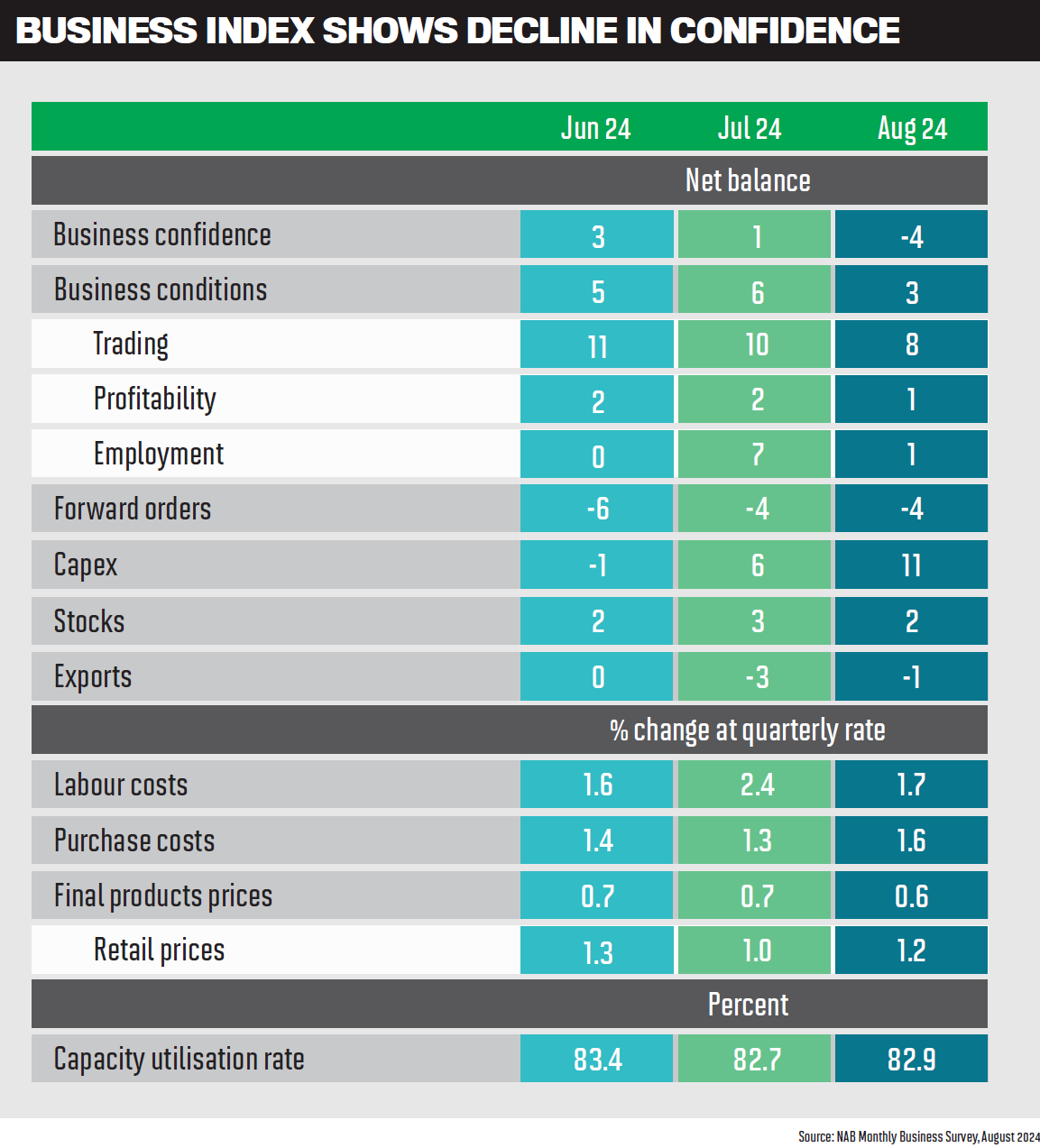Working with brokers to meet SME finance needs

The struggles that small to medium businesses face cast a grey cloud over the lending landscape, but it’s not all doom and gloom.
While SMEs cope with a spending downturn, higher interest rates and inflation, labour shortages, payment delays and more, this is exactly the time when non-bank and private lenders and their broker partners are up.
Commercial and asset finance brokers are perfectly placed to assist their clients with the tailored and flexible finance solutions that non-banks offer, from alt-doc or low-doc loans to cash flow lending or extinguishing tax debt. MPA asked third party heads from Assetline Capital, Aquamore, Liberty, Millbrook Group, Pepper Money and Prospa for their insights on SME lending and about the opportunities for brokers. David Bushby, CEO of CAFBA, also shared his views.
Financial challenges
The Equifax Quarterly Commercial Insights June 2024 report showed business credit applications falling by 1.6% overall, including a -0.2% drop in business loan applications, an 8.1% decline in asset finance applications, and a 3% rise in trade credit applications.
NAB’s Monthly Business Survey for August showed business confidence in negative terri- tory, while business conditions also fell, and purchase cost growth rose to 1.6%.
So, how can non-banks and private lenders work alongside brokers to adjust their strategies accordingly and support business growth?
Royden D’Vaz (pictured below), Assetline Capital’s general manager of distribution and partnerships, says the non-bank strives to adopt a proactive and flexible approach “to adjust to what the market is telling us”.

“It’s essential as a non-bank lender that we continue to effectively support the business growth of brokers, who trust us with their borrowers’ financial needs and objectives,” D’Vaz says.
Brokers are encouraged to focus on areas of continuous demand such as short-term loans, working capital and other products, including SMSFs, long-term alt-doc loans and bridging loans – all of which Assetline offers.
“We always aim to equip brokers with up-to-date market insights, training and tools that help them understand and respond to the shifting trends in SME lending,” D’Vaz says. “This includes understanding which sectors are showing growth.”
George Lyall (pictured below), head of origination at Millbrook Group, says the non-bank works closely with broker introducers to ensure loan applications are properly vetted and assess the client’s borrowing capacity.

“This is crucial for assisting clients in sensible lending pursuits that has regard for a borrower’s current circumstances and likely growth expectations,” he says.
Millbrook also advances loans for a shorter-term duration, with a focus on the intended source of repayment and the likelihood of such events occurring.
“For our construction lending, we always include a construction contingency that provides a reserve to accommodate any cost escalation or variations that may be encountered throughout the course of the project development.”
The economic environment is presenting challenges for SMEs and brokers alike, says Pepper Money general manager mortgage and commercial lending Barry Saoud (pictured below).

He says small businesses are the lifeblood of Australia, and despite the recent decline in overall business credit applications, Pepper Money is focused on supporting brokers to help SMEs thrive.
“In the last six months to date, we have experienced a 55.8% surge in SME settlements,” Saoud says.
“We work closely with brokers to adapt our strategies by offering flexible lending solutions, such as our commercial real estate loans with high LVRs and extended loan terms. This enables brokers to offer tailored solutions to businesses, whether they are looking to manage ATO tax debt, refinance or seek growth opportunities.”
By leveraging Pepper Money’s fast service- level agreements and eliminating commission clawback on early payouts for commercial loans, Saoud says “we enable brokers to provide more competitive options to support their clients’ business growth”.
David Smith (pictured below), Liberty’s chief distribution officer, says Liberty has always taken a flexible, free-thinking approach, which means “we are well positioned to support brokers even in challenging conditions”.

“Our specialised BDMs offer support and training to brokers, empowering them to provide tailored solutions to meet the unique needs of SMEs,” says Smith.
“Our BDMs and underwriters leave no stone unturned when working with brokers, ensuring all options are exhausted in the search for a solution that works best for the customer.”
Prospa general manager sales and partnerships Roberto Sanz (pictured below) says SMEs are bearing the brunt of economic pressures, with supply chain costs, rate hikes and lower consumer demand driving down confidence.

Many small business owners have become cautious about taking on more debt. “This has created a huge opportunity for brokers to step in to educate their clients on the different funding solutions that could help to relieve some of their cash flow pressures,” says Sanz.
Sole traders and micro small businesses are being hit the hardest. “However, we’re seeing increased demand from what we refer to as ‘established small businesses’.”
These are businesses that have been trading for more than three years, have a credit score above 650 and have learnt to weather challenging market conditions. Sanz says this is a prime segment brokers should be targeting right now.
Prospa understands that every business is unique, and works closely with brokers to understand their clients’ needs and find personalised solutions.
“We invest heavily in educational tools and resources, third-party research, as well as continually review our own credit and risk appetite to help ensure we deliver the best solutions,” says Sanz.
Matthew Porch (pictured below), head of distribution at Aquamore, says commercial lending is increasingly shifting towards non-bank and private lenders due to their flexibility – and in Aquamore’s case, the judgemental credit assessment of commercial solutions.

Porch says Aquamore’s holistic approach is beneficial for businesses seeking larger-ticket funding to seize a time-sensitive opportunity, refinance or facilitate growth.
“Economic conditions appear to be becoming more favourable with inflation easing, but with reduced spending, many businesses continue to feel the pinch,” Porch says. “That said, it’s important to remember that disruption breeds innovation. Private lending is well placed to support businesses seeking growth with fast, flexible, short-term funding.”
Aquamore encourages brokers to see themselves as finance brokers, rather than standalone mortgage brokers or commercial brokers, to ringfence clients and boost revenue. Porch says this may involve writing (or ‘tick and flicking’) more commercial deals or collaborating with commercial finance specialists.
He points out that while brokers must consider the client’s best interests, this doesn’t necessarily mean being lured in by what appears to be the cheapest interest rate. “Commercial lending is different from residential lending, and a solution trumps a headline rate. It’s also wise to be confident in a lender, based on their track record, market reputation and funding lines – particularly in the private lending sector.”
Aquamore strongly recommends that brokers seek to upskill themselves to be better placed to analyse clients’ P&Ls, balance sheets and cash flow patterns, which will in turn uncover ‘hidden’ commercial finance opportunities.
“It’s prudent to collaborate with an accountant to create a personal or business plan to realise goals,” says Porch. “Relationships are key: brokers, lenders, aggregators and industry associations can play a key role in your broker business.”
CAFBA CEO David Bushby (pictured below) says the primary advantage brokers bring to SME clients is their knowledge of different finance options and their ability to present options to clients that are tailored to and match their specific needs.

“Brokers should always be taking this strategic approach when delivering outcomes for commercial clients, in good times and bad,” says Bushby.
In tighter times, it’s even more important for brokers to spend time with clients explaining options, the impacts on cash flow and ability to service debt.
Brokers should specifically consider tax debt, if any, and making provision to transfer that debt from the ATO to an established lender on better terms,” Bushby says.

Support for broker diversification
With mortgage brokers writing 73.7% of all new home loans in the July 2024 quarter, according to the MFAA, it’s no wonder brokers are looking at diversifying into commercial and asset finance.
Bushby says CAFBA welcomes residential brokers who wish to increase their offering to include commercial clients, but it’s important to understand that different and additional skills and experience are required to successfully do so.
CAFBA has developed a bridging diploma that teaches specific skills at all stages of a broker’s career, and specifically for resi brokers looking to diversify.
The latest MFAA Industry Intelligence Service report (1 April to 30 September 2023) shows that the number of mortgage brokers also writing commercial loans fell 7.58%, but the value of commercial loans settled by mort- gage brokers was the highest on record.
Sanz says the number of mortgage brokers settling business with Prospa has remained consistent, with the average deal size actually increasing. “We believe this is the result of the education and support we continue to provide mortgage brokers to diversify their business,” he says.
From extensive product guides and resources to dedicated local BDMs with unparalleled market insights, Prospa has been able to equip brokers with a differentiated service model that ensures they have everything they need to quickly identify opportunities and close business faster.
Sanz says flexible product and service offerings are essential to helping brokers source the best solutions.
“For business owners eyeing growth or expansion opportunities, a business loan could be a great fit, but for those looking to overcome current cash flow challenges or who just want greater peace of mind, a line of credit is a great solution.”
Assetline Capital recognises the huge potential of the SME sector and the value brokers bring when they expand their services, says D’Vaz. It provides brokers with tailored training through webinars and in-person events that deepen their understanding of SME lending, helping them identify opportu- nities and confidently advise their clients.
“Our product range includes a comprehensive suite of commercial lending products designed to meet the varied needs of SMEs,” D’Vaz says. “This, combined with our training and support, allows brokers to offer their clients tailored solutions, whether they require working capital, SMSF investment funding, construction project finance, or simply a solution to settle a property quickly.”
Porch says there’s widespread acceptance of diversification into alternative finance. “It’s encouraging to see so many brokers proactively upskilling to understand the nuances of the different lending profiles.”
Aquamore collaborates with lenders and aggregators in the non-bank sector to educate brokers about SME lending, hosting in-person and online events.
It also hosts regular education workshops and seminars to upskill brokers on commercial lending. Porch says these include tips for spotting opportunities, along with strategies brokers can implement to support their client base.
“The national relationship, credit and operations teams have been extended to ensure the company continues to make quick and consistent credit decisions nationwide.”
Aquamore’s funding offer to the market takes the form of a fully drawn advance and is split into five different product types, says Porch. These are further categorised into assessment type, documentation requirement and loan tenure – ensuring all market sectors get aligned solutions.
Liberty’s reach and the experience of its commercial and business teams means that they can share real-world success stories from brokers who have diversified into commercial lending with Liberty’s support, says Smith.
“We have seen how helping SME customers has substantially contributed to broker business growth and strengthened client relationships beyond home loans.”
Smith says Liberty’s focus on education, product diversity and expert advice helps brokers grow their businesses and ensure they have the right tools and knowledge to meet SME borrowers’ evolving needs.
“We work closely with our broker partners to help them provide the kind of support business customers require in the current economic climate.”
Saoud says given the recent trends high- lighted in the MFAA report, it’s crucial to encourage more mortgage brokers to diversify into SME lending. Pepper Money leads the way in broker education and making things easier, regularly running workshops for commercial lending, both as one-on-one sessions and in groups.
“A broker can reach out to their Pepper Money BDM if they would like to jump in on one of our sessions. This extends beyond residential lending, allowing brokers to present a broader range of solutions, such as business lines of credit and asset finance.”
Brokers also get direct access to the expert advice and support offered by Pepper Money’s credit teams.
Millbrook is a regular attendee at aggregators’ professional trade days as well as industry conferences, says Lyall.
“We quite often interact with new commercial brokers and provide guidance on the key aspects of a loan application for new-to-commercial brokers.”
Millbrook also provides a monthly news alert to brokers, including a regular report on typical transactions – another opportunity for further learning about market trends.
“Our in-house credit team are always available; brokers have a direct line of contact with our credit analyst to talk through any queries,” Lyall says. “This is not only educa- tional but makes the process a lot smoother for the broker.”

Learning from broker feedback
Non-banks understand the importance of broker feedback on their products, policies, platforms and services, given brokers are so crucial to their business model.
At Pepper Money, broker feedback is a key driver of how “we evolve our products, policies, and processes”, says Saoud. “Brokers’ feedback helps us identify gaps in our product offerings and develop new solutions that address specific market demands.
“We actively engage with brokers to understand their clients’ challenges, particularly in areas such as cash flow management and debt consolidation.”
Saoud says broker input helps Pepper Money shape its lending policies, refine its refinancing solutions for ATO tax debts and offer a flexible product range that caters to both prime and near prime customers.
Smith says brokers are at the coalface, talking to customers every day, so the insights they provide on customer needs and expectations is invaluable.
Liberty regards broker feedback as essential to its success; it helps the non-bank understand “how we can best serve brokers and clients in any economic environment”.
“We have always championed the third party broker channel and value our relationships with brokers and business partners,” Smith says.
Porch says Aquamore enhances it products and develops new products to meet current and emerging demand. These include no-doc, alt-doc, lease-doc, rapid refinance and SMSF offerings.
Aquamore has also increased its loan size to $7.5 million after market research indicated this sector of the market was underserviced in terms of debt size. This has been well received by businesses seeking funding to consolidate debt or make substantial investments.
Millbrook values the feedback from its broker network, says Lyall, and the key benefit relates more to industry and macro economic pressures that are noteworthy.
“We also avail of information on the broader market that can impact our policy framework from other sources as well. These include but are not necessarily limited to external professional consultants such as valuers and quantity surveyors and industry commentators.”
Lyall says Millbrook’s processes are well developed and robust, providing a respon sive and professional solution for borrowers and brokers.
D’Vaz says brokers are out there directly interacting with SMEs and understanding their evolving needs. “Their feedback helps us identify gaps in our product offerings and adapt or innovate new solutions that better align with what businesses need right now.
“For example, if brokers report that SMEs are struggling with cash flow but hesitant to take on traditional loans, we can respond by developing more flexible options like revolving credit facilities or shortterm financing solutions.”
Earlier this year, in response to broker feed back, Assetline Capital expanded its construc tion offerings with an altdoc construction loan solution for $1 million to $5 million. “We worked very closely with brokers, ensuring that we were delivering a product that filled a gap in the market,” says D’Vaz.
Sanz says Prospa has always been a partnerled business and regularly seeks feedback on “how we can help our partners create more value for their client”.
“This includes collecting feedback face toface at events, through questionnaires and over the phone to help shape new products, tools and the decisions we make at Prospa.”
Sanz says brokers recently reported that their clients were looking for a broader range of product solutions that included longer terms, higher limits and greater payment flexibility.
“We’re pleased that we’ve been able to deliver that so brokers and their clients can make more business happen.” This includes
offering higher limits, with a business line of credit up to $500k and fiveyear terms for business loans above $150k, as well as added repayment flexibility such as unlimited extra repayments to help businesses save on interest and pay down their loans faster.

Critical role of technology
Smith says technology is an integral part of the way Liberty supports brokers and customers throughout the lending process.
“Whether it’s digital identity verification or the use of AI, we’re continuously innovating our online platforms and services so brokers can focus on finding customer solutions.
“We expect there will be even more tools available in the near future to help us continue to meet the changing needs of customers and deliver positive outcomes.”
Porch says private lending continues to be in demand, offsetting the restricted credit appetite of both traditional lenders and increasingly nonbank lenders.
“Aquamore considers every deal holisti cally on a casebycase basis, applying a judgemental credit approach versus being policybased with strict credit criteria. We expect this to remain a high priority for ‘top end of town’ businesses that require indi vidual solutions for often multifaceted deals.”
Lyall says technology is an essential plank for any lending business and needs to be continually monitored and upgraded where it makes sense to do so.
A large portion of our business is, however, tailored to individual circumstance and is not necessarily standardised.
“Millbrook firmly believes that there will always be the need for a human touch in the SME commercial space. It comes back to service – brokers and clients want to talk to the credit assessor or the BDM regarding the transaction.”
Sanz says technology has played a trans formative role in the industry over the past decade, for example with the move from paper to digital statements.
We’re increasingly seeing it play a critical role in helping advisers set expectations up front and streamline the loan process to maximise speed and transparency.”
An example is Prospa’s credit assessment process; its proprietary Credit Decision Engine. This leverages realtime data and industry insights, including risk factors, pricing models and credit policies, to ensure accurate assessments of SME creditworthi ness to help find the best solutions.
“It has increased the speed at which brokers can quickly identify, realise and convert an opportunity in hours, helping them to better serve their clients,” says Sanz.
Prospa will be at the forefront of a new leap in tech innovation, he says. “We have been developing new technology … we believe this will change the way brokers experience business lending.”
D’Vaz says that with the increasing volumes of SME loans, Assetline Capital has introduced technology tools to make loan applications easier, reducing its approval times and improving its processing and decisioning capacity.
“We selectively chose and created tools that take a broker from receiving a quote with our Quick Quote tool, submitting a scenario via our Submit a Scenario form, lodging an application on LoanApp, right through to loan processing and approval.”
Technology, particularly AI, is rapidly transforming SME lending, with non-banks such as Pepper Money at the forefront, says Saoud.
“From data-driven technology that slashes the time to yes, to creating innovative new products that make the most of emerging market opportunities, we have the agility and willingness to explore new ways of helping our customers and brokers to succeed.”
Pepper Money serviceability calculators streamline the lending process for brokers, enabling faster approvals and a smoother experience for their clients.
“These tools are designed to help brokers navigate complex scenarios more efficiently, offering tailored solutions that are critical in today’s fast-paced lending environment.”
Market trends
Bushby says the decline in business loan applications cited in the Equifax report is not reflected across the board.
“In the asset finance space, there has been a notable decline in financing for lifestyle industries such as hospitality and recreation, but there is still a healthy credit appetite in capital-intensive industries like transport, manufacturing, materials handling and civil construction.”
Porch says the ‘market divide’ will become more apparent, with the major banks continuing to focus on ‘vanilla’ residential borrowers, while non-banks and private lenders support an increasing volume of prime or near prime borrowers.
Aquamore expects that the lion’s share of SME and commercial debt will be fulfilled by non-bank and private lenders as the major banks continue to focus on reducing their cost-of-capital charges in an uncertain market.
“Turnaround times, flexible loan terms and conditions attract commercial borrowers to non-bank and private lenders,” says Porch.
Lyall says brokers should be aware of the completion risk for project developments and possible builder failure.
“Brokers should also look to foster deeper relationships with non-bank lenders such as Millbrook who are able to provide a more flexible and speedier solution than the main- stream banks.”
Flexibility in funding structures and speed to market have becoming increasingly apparent, and this is where Millbrook excels, says Lyall.
Saoud says there’s increasing demand for non-bank funding, particularly as tradi- tional banks tighten their credit lending. “This has driven growth in alternative lending products, such as our business line of credit, which offers the flexibility SMEs need to manage cash flow and meet ongoing obligations. “
Another emerging trend is refinancing tax debts, especially as ATO pressure increases for SMEs.
Pepper Money is meeting demand to support SMEs with discounted Near Prime Clear rates for ATO debt consolidation, says Saoud. The offer features unlimited debt consolidation, including personal, private and business debts considered on Prime, and six options to choose from when verifying SME income.
As traditional banks become more cautious, alternative lenders like Assetline Capital are playing a larger role in the SME space, says D’Vaz.
Non-banks are becoming more prominent, offering competitive rates and more flexibility, so brokers should explore partnerships with them to broaden their product offerings.
“Short-term loans are gaining traction as businesses look to maintain cash flow and navigate unpredictable revenue streams,” D’Vaz says. “Brokers should focus on these adaptable options.”
Smith says business borrowers need guidance and support now more than ever, so they are increasingly turning to brokers. “Providing SME lending support is a great way for mortgage brokers to grow their businesses, as these are among some of the customers currently in need of the greatest support.”
Liberty is also seeing an increase in the need to support SMEs with custom low-doc or alt-doc solutions.
Smith says the lender prides itself on offering highly skilled and accessible support to brokers, who can liaise directly with a local team of credit assessors. “Our bespoke approach gives us the flexibility to assess every customer on their unique circumstances.”



